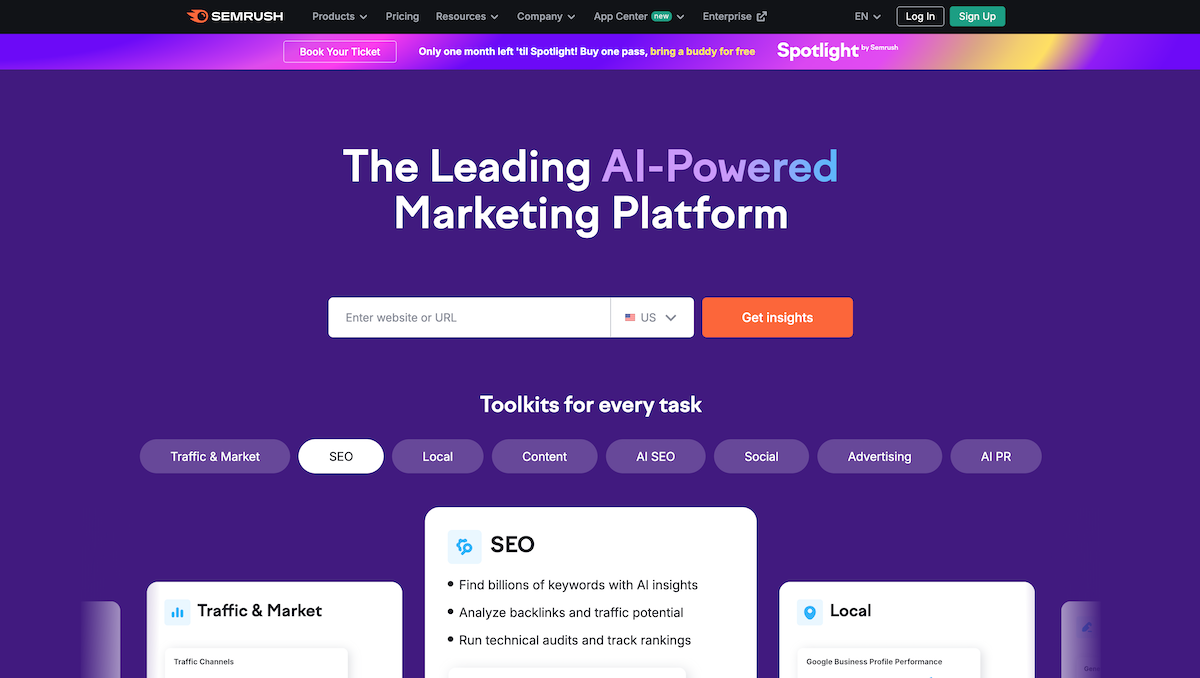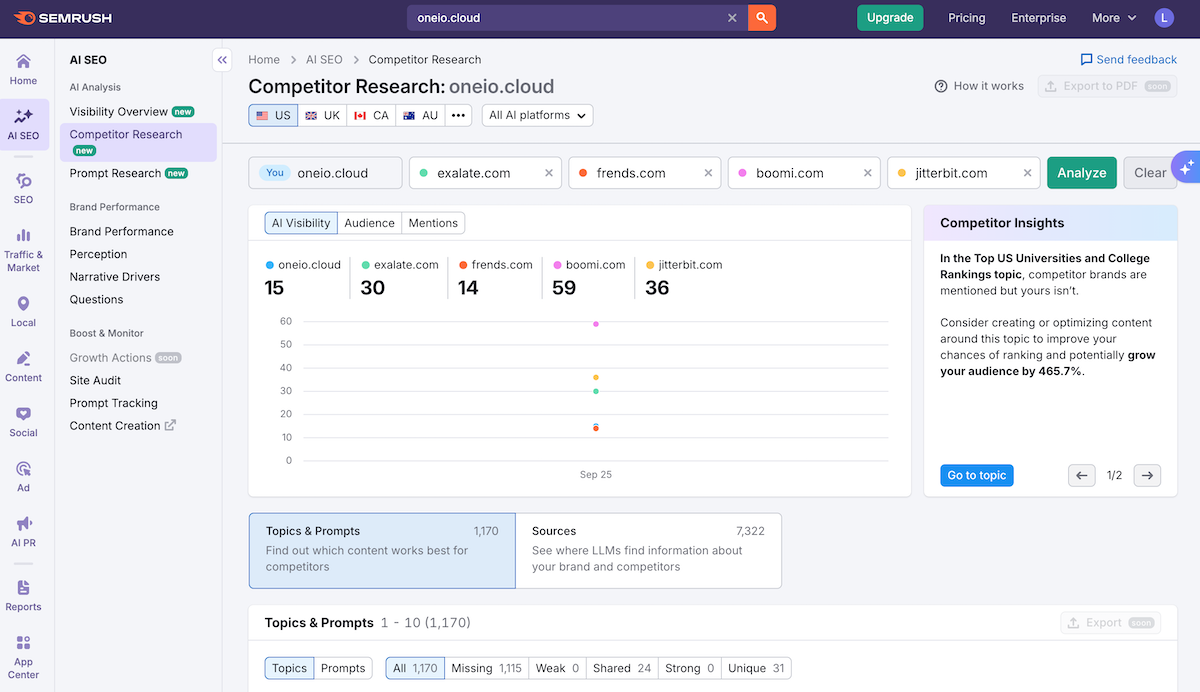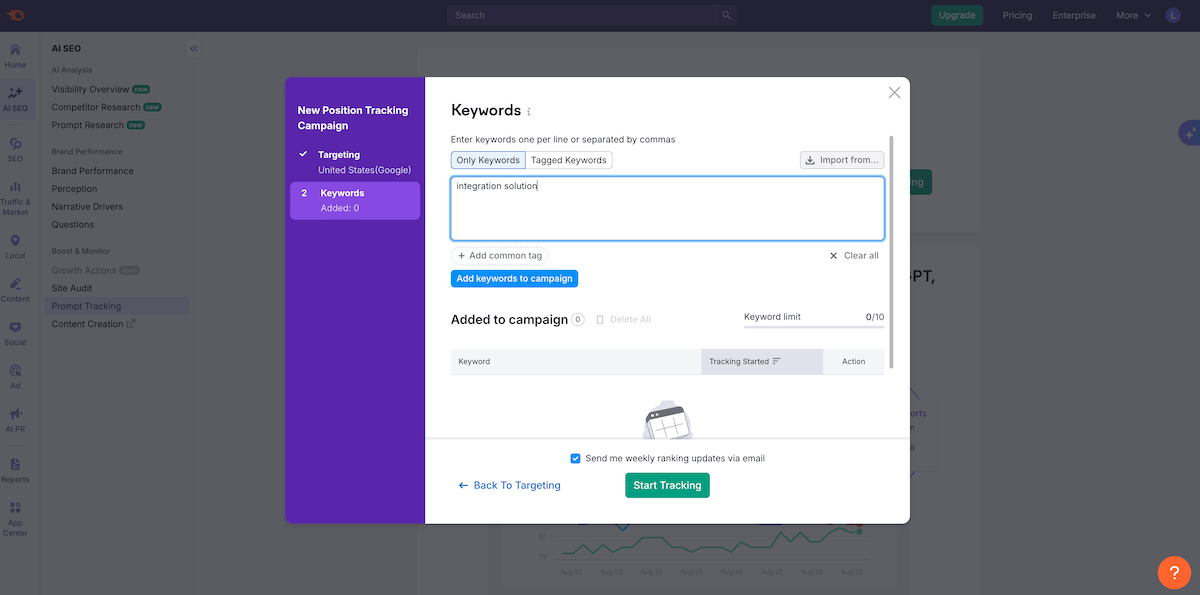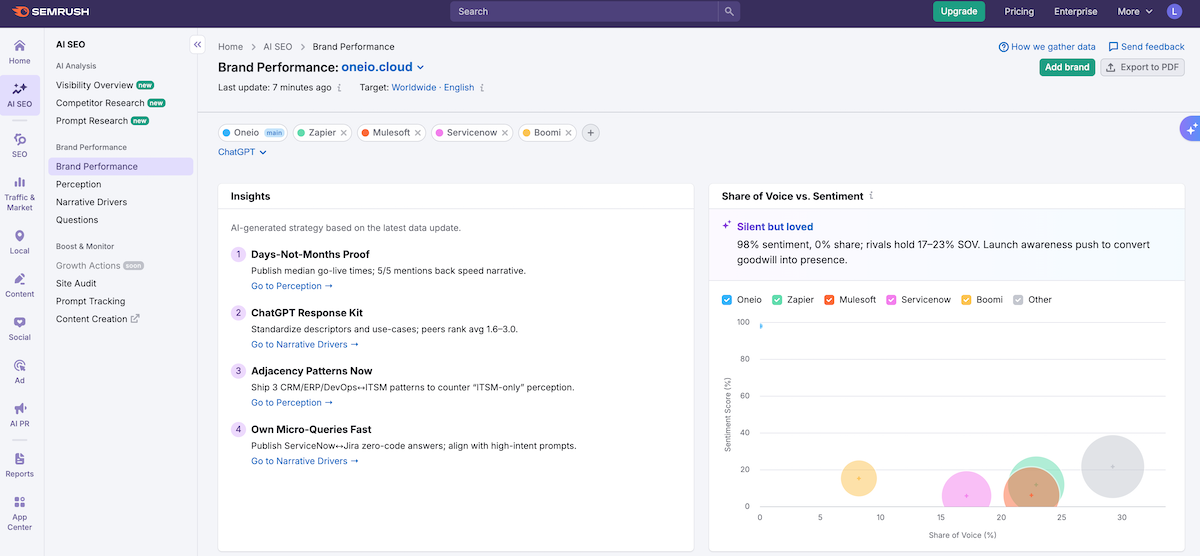My SEMRush AI SEO Visibility Review (SaaS and B2B Tech Focus)
The bottom line about using SEMRush for AI SEO / AI visibility tracking
| Feature | Rating | Details |
|---|---|---|
| Multi-AI Engine Coverage | 2/5 | Includes ChatGPT, AI Overviews and Google AI Mode. They promise Gemini visibility "soon." |
| User Experience | 2/5 | Familiar SEMRush user experience contains a lot of UX quirks and limitations. Feels like it has been created in a rush (no pun intended.) |
| Data Accuracy | 2/5 | Odd limitations to tracking competitors and selecting relevant prompts related to SaaS / B2B niche. |
| AI Traffic Attribution | 4/5 | In the data you're able to see everything looks valid. The key challenge is that dashboards will likely be misconfigured from start, giving misleading insights. |
| Actionable Insights | 2/5 | "Growth Actions" functionality is planned, but not available yet. Many of the dashboards seen were not accurate enough for actionable insights. |
| Lead/Conversion Tracking | 2/5 | No stand out conversion tracking or analytics integration functionality. |
| Brand Sentiment Tracking | 4/5 | There is a pretty comprehensive brand tracking dashboard available, including plenty of comparisons vs. competitors. However, smaller SaaS vendors were not available in lists, so comparison is most suitable for large businesses. |
| Brand Presence Overview | 4/5 | Detailed analysis of brand visibility across different LLMs, including some prescriptive insights on how to (re-)frame positioning in AI search results. |
| Competitor Analysis | 2/5 | You can run competitive dashboards vs. one or more competitors. However, the functionality tested appeared buggy. Typing in one brand repeatedly gave the choice of another. |
| Data Freshness | 4/5 | Unlike other AI visibility tools that run on a prompt level, SEMRush reporting focuses on a keyword level. It looks to happen on a daily basis. |
| Setup Complexity | 2/5 | SEMRush had a quickstart on-boarding, but the problem happens when you disagree with the configurations. It doesn't seem to remember your preference for competitors and past configurations of reports. |
| Pricing Value | 2/5 | At $99/month SEMRush offers one of the cheapest AI visibility solutions in the market. However, at the time of testing the solution felt less commercially ready than most alternatives, so what you're essentially paying for is a beta. |
Overall rating: 2.6/5SEMRush is looking to use their legacy in SEO visibility tracking to enter the AI SEO space. They do not have as ready a solution as many AI-native startups in the space, but with their large customer base they have an opportunity to take a large portion of the SEO + GEO market in a combined solution. |
| Pros of SEMRush AI SEO | Cons of SEMRush AI SEO |
|---|---|
| 1. Integrated SEO / digital marketing suite: Since 2008 SEMRush have been building a single platform for marketers across SEM/SEO and now AI SEO. | 1. Difficulty adjusting scope of project: In our testing SEMRush gave a really large market audience (incl. comparisons to enterprise sized competitors) which lead to massive overestimation of AI SEO need and opportunity. |
| 2. Low cost option: If you're limited to spending $99/month, SEMRush is a solution with some of the most functionality at that price point. | 2. Buggy interface: There are frustrating quirks in the UX. When you try to configure a competitor, it automatically configures another domain than what you choose. When you try to configure a prompt it suggest a prompt that is not relevant. |
| 3. International reporting: By default, SEMRush looks to have more reporting on AI SEO across different geographies (US, UK, Australia) than other solutions. However, this is currnetly limited to English speaking markets, not DE, FR etc. | 3. Lack of content optimization tips: Compared to leading AI visibility tools SEMRush gives less prescriptive suggestions what you should do to increase visibility on specific prompts. There are prescriptive suggestions, but these are not so easily configured to my key use cases as an SEO specialist. |
What is SEMRush AI SEO?
SEMRush is an established all-in-one digital marketing platform that has expanded into AI visibility tracking, monitoring how brands appear across ChatGPT, Google AI Overviews, and Google AI Mode, with promised Gemini support coming soon. The platform offers keyword-level daily tracking, brand sentiment analysis, competitive benchmarking, and AI traffic attribution dashboards.
As part of the larger SEMRush suite (used by over 10 million marketers globally), the AI visibility features leverage the company's existing keyword and SEO infrastructure, making it a possible add-on extension for current customers looking to consolidate their marketing intelligence tools.

SEMRush homepage (semrush.com)
What are the key features of SEMRush?
- Multi-Engine Visibility Tracking Monitors brand presence across ChatGPT, Google AI Overviews, and Google AI Mode (with Gemini support promised "soon"), providing keyword-level tracking of how your brand appears in AI-generated responses and identifying which competitors are mentioned alongside your brand.
- Brand Sentiment & Positioning Analysis Delivers comprehensive dashboards showing how AI platforms represent your brand, including sentiment analysis, competitive comparisons, and prescriptive insights on reframing your positioning in AI search results—though best suited for larger enterprises as smaller SaaS vendors often lack sufficient data.
- AI Traffic Attribution Provides visibility into traffic and engagement driven by AI search engines with daily data updates, though default dashboard configurations often require manual correction to avoid misleading insights about actual AI-driven traffic sources.
- Keyword-Level Daily Reporting Unlike competitors that focus on prompt-level analysis, SEMRush operates at the keyword level with daily refresh cycles, leveraging its existing SEO infrastructure to track how target keywords perform across different AI engines over time.
- Competitive Benchmarking Dashboards Allows side-by-side comparison of your brand visibility against one or more competitors across AI platforms, showing share of voice and mention frequency—though the feature currently suffers from bugs and limited brand recognition for smaller B2B/SaaS companies.
- Planned Growth Actions (Coming Soon) Promises actionable recommendations for improving AI visibility based on performance data, though this critical feature is not yet available, leaving users with descriptive dashboards but limited prescriptive guidance for optimization.
How did I test SEMRush AI SEO?
This test was made in October 2025. Be aware that these AI tools evolve quickly, and new features are removed and added weekly.
I personally tested SEMRush as part of a larger effort to test all the major AI search visibility platforms. Therefore, this is not an AI-generated review based on the opinions of others.
This review is based on my personal experience of using SEMRush for a real-live SaaS / B2B tech company, using the $99/month subscription.
Can SEMRush provide you with accurate AI engine visibility?
- Does SEMRush provide multi-AI search engine visibility?
Yes, it currently provides visibility for ChatGPT, AI Overviews and AI Mode. Gemini is promised "soon."
- Does SEMRush offer a good user experience?
To some extent SEMRush provides a decent user experience. There are very visible bugs and quirks in the UX. In some areas the user experience looks to be copied from existing SEO reporting (eg. referencing "keywords" instead of "prompts." In other areas, the prescriptive suggestions feel out of place. For example, for an integration software provider it recommended creating content related to "Top universities in the United States" to get more visibility.

For unknown reasons SEMRush AI SEO recommended creating content related to "Top US Universities and Colleges" to our tested brand, a software-as-a-service integration platform from Finland.
- Does SEMRush give good value for money?
This depends. It's lower cost than most options. If you're an existing SEMRush user with many years of historic SEO reporting, it may be a good value add-on upgrade with hopes of improved functionality over time. If you're comparing it to newer AI visibility startups, it lacks some of the core prescriptive insights helping you get more LLM visibility.
- Does SEMRush give accurate and trustworthy data?
Yes, I believe based on testing that SEMRush gives accurate information, as long as the reports are configured correctly.
- Does SEMRush offer actionable tips beyond just data?
Yes, to some extent. It misses an actionable insights dashboard offered by many other solutions, but does promise "Growth Actions" functionality coming soon.
💡 Here is our detailed review of Otterly AI for AI search visibility.
- Does SEMRush show you the estimated traffic from AI search engines to your business?
Yes, it looks to be especially accurate through the CDN integration. There was an integration with Google Analytics I did not include as part of my test.
- Does SEMRush offer a brand's sentiment tracking?
Yes. Based on testing it's brand sentiment reporting looks as detailed as best alternatives.
- Is SEMRush suitable for SEO agencies or multi-account set-ups?
Yes. It was quick and easy to set up more than one website property / entity in SEMRush. This functionality makes it a possible solution for SEO agencies.
💡 Here is our detailed review of Scalenut for AI search visibility.
How does SEMRush AI SEO work?
SEMRush's approach involves gathering a large collection of common queries that users typically ask on AI platforms, then running these queries through various LLMs like ChatGPT, Google AI Mode, Gemini, and Perplexity to analyze how different AI systems respond. However, unlike some competitors who monitor live consumer interfaces, SEMRush's documentation doesn't explicitly clarify whether they query APIs or scrape actual front-end experiences.
Here are the 3 core components of how SEMRush AI SEO works:
Proprietary Query Collection & Processing: SEMRush gathers a vast collection of common queries covering various topics and interests related to your brand and competitors, then runs these queries through LLMs to see how different AI systems interpret and respond to them. The platform collects and refreshes over 100 million prompts monthly, though their methodology doesn't specify whether these are scraped from actual user behavior or generated algorithmically.
Keyword-Level Tracking Approach: Unlike competitors that focus on prompt-level analysis, SEMRush's Enterprise tool generates brand-specific prompts across different stages of the buyer journey, then evaluates your brand's visibility and mentions across LLMs. The platform operates at a keyword level rather than capturing the full conversational context of how users actually interact with AI engines.

Unlike most AI visibility tools, SEMRush keyword tracking is done on a keyword, not prompt level.
Response Analysis & Benchmarking: The toolkit analyzes AI responses to assess how your brand is mentioned compared to competitors, evaluates the tone and attributes used to describe your brand, and identifies emerging topics and user interests. This data is collected and refreshed weekly for brand sentiment, narratives, and share of voice in Brand Performance reports, with daily updates for Prompt Tracking.
The Documentation Gap
Unlike competitors who explicitly describe their technical methodology, SEMRush's documentation focuses more on what the tool does rather than how it works technically. There's no clear statement about whether they:
- Monitor live consumer interfaces or rely on API calls
- Capture real-time RAG (Retrieval-Augmented Generation) results with citations
- Query actual front-end experiences that normal users see
This lack of transparency makes it difficult to assess whether SEMRush is capturing the same dynamic, real-time information that end users experience, or if they're working with more static API responses that might miss context.
What data does SEMRush AI visibility collect?
AI search brand visibility
SEMRush analyzes millions of AI conversations to reveal brand perception and positioning across LLMs like ChatGPT, Google AI Overviews, Google AI Mode, and Perplexity. The visibility dataset includes:
- AI Visibility Score: A benchmark score from 0-100 showing your overall presence in AI search
- Brand mentions: Total count of how often your brand appears in AI-generated responses
- Monthly Audience: Estimated reach of your brand across AI platforms
- Sentiment analysis: Analysis of the tone and attributes AI uses to describe your brand
- Share of Voice: Your brand's mention frequency compared to competitors in your market, updated weekly
- Topic coverage: Specific prompts and topics where your brand is mentioned or notably absent
- Platform breakdown: Performance across individual AI engines
Cited sources tracking
The platform measures visibility, mentions, competitor gaps, and cited sources, though the documentation provides limited detail on citation tracking compared to competitors. The source tracking includes:
- Citation sources: URLs cited in AI-generated responses where your brand is mentioned
- Source frequency: Which pages are driving your visibility in AI search results
However, SEMRush's citation tracking appears less comprehensive than specialized competitors, with limited visibility into citation authority rankings or detailed competitor citation analysis.
Prompt and competitive analysis
- Prompt Research: Discover and prioritize AI search topics with volume, difficulty, and user intent metrics—essentially keyword research for AI platforms
- Competitor gaps: Identify prompts and topics where competitors are getting cited but you aren't, allowing you to spot visibility gaps
- Historical trends: Track changes over time with monthly updates for Visibility Overview, weekly updates for Brand Performance, and daily updates for Prompt Tracking
- Strategic recommendations: AI-generated actionable recommendations for refining brand positioning, messaging, and product offerings
Where does SEMRush take the information?
SEMRush gathers a vast collection of queries and runs them through various LLMs including ChatGPT, SearchGPT, Google's AI Mode, Gemini, and Perplexity to analyze how different AI systems respond. The platform collects and refreshes over 100 million prompts monthly.
However, SEMRush's documentation doesn't provide the same level of technical transparency as some competitors. Key questions remain unanswered:
- API vs. Live Monitoring: The documentation doesn't specify whether SEMRush queries static LLM APIs or monitors actual consumer-facing interfaces
- RAG vs. Training Data: It's unclear whether results capture real-time Retrieval-Augmented Generation with live web data, or if some results reflect static training data
- Query Generation Method: Unlike competitors who detail their prompt generation methodology, SEMRush doesn't explain whether queries are algorithmically generated, based on real search data, or a hybrid approach
SEMRush uses machine-learning algorithms and trusted third-party providers for its broader data collection, but specific details about AI visibility data collection methodology are not publicly documented.
The bottom line: While SEMRush provides extensive data on brand visibility across AI platforms, the lack of transparency about their technical methodology—particularly whether they monitor live consumer interfaces or rely on API calls—makes it difficult to verify if their data captures the same experience actual users see when interacting with AI search engines.
What do I think about SEMRush's data quality?
As a major SEO visibility vendor with large resources and history providing accurate visibility data I have confidence that SEMRush gives accurate data for AI SEO.
What would I improve in SEMRush AI SEO?
Here are the points that I would improve in SEMRush AI SEO:
1. Expand AI Engine Coverage Beyond "Coming Soon" Promises
- Currently limited to ChatGPT, Google AI Overviews, and Google AI Mode
- Competitors already track Perplexity, Copilot, Claude, Meta AI, and other platforms
2. Fix Critical UX Bugs and Configuration Memory
- Competitor configuration automatically selects wrong domains
- Interface confusingly mixes "keywords" and "prompts" terminology
- System doesn't remember user preferences or past report configurations
- Users must repeatedly reconfigure dashboards, fundamental usability failure
3. Improve Prompt Relevance for B2B/SaaS Niches
- Struggles with competitor tracking and prompt selection in SaaS/B2B verticals
- Generates irrelevant suggestions (e.g., "Top universities" for integration software)
- Smaller SaaS vendors missing from competitor lists
4. Deliver the Promised "Growth Actions" Functionality
- Critical "Growth Actions" feature not yet available despite being advertised
- Dashboards lack actionable, prescriptive insights
- Competitors provide specific, prescriptive recommendations per prompt
5. Provide Transparent Methodology Documentation
- Unclear whether tool monitors live interfaces or uses static API calls
- Missing details on query generation methodology
💡 Here is our detailed review of Peec AI for AI search visibility.
How is the SEMRush AI SEO user experience?
SEMRush AI SEO is integrated into the broader SEMRush digital marketing suite. The user experience is overall clean and clear.
The main challenge appears to be that toggles and drop down options don't quite do what you want them to do. For example, if I wanted to fix the competitors in the "Brand Peformance" example below, I could not choose a more relevant integration solution from a list than Mulesoft and Servicenow. When you do add a new option, it looks like the reporting does not remember your preferences.

SEMRush user experience (semrush.com)
How much does SEMRush AI cost?
SEMRush positions its AI SEO toolkit as one of the most affordable options in the AI visibility tracking market. The pricing is straightforward and transparent compared to many competitors.
Here's the pricing structure:
AI SEO Toolkit - $99/month
- Visibility Overview: 300 queries per day
- Brand Performance reports: 1 domain included
- Prompt Tracking: 10 prompts per LLM (ChatGPT and Google AI Mode)
- Monthly updates for Visibility Overview
- Weekly updates for Brand Performance
- Daily updates for Prompt Tracking
- No contract—cancel anytime
Add-ons:
- Additional domain for Brand Performance: $99/month per domain
- Additional subuser license: $99/month per user
Enhanced Prompt Tracking (with existing SEMRush subscription):
- AI SEO + SEO Pro: 50 prompts per LLM (5 folders)
- AI SEO + SEO Guru: 100 prompts per LLM (15 folders)
- AI SEO + SEO Business: 200 prompts per LLM (40 folders)
What I experienced during testing:
During my testing phase with the $99/month subscription (€94 EUR), I had access to:
- Basic AI visibility tracking across ChatGPT, AI Overviews, and Google AI Mode
- 10 prompts for daily monitoring per LLM
- Brand Performance dashboard for one domain
- All core features except enhanced prompt tracking limits
The package provided the fundamental features needed for AI visibility tracking, though the 10-prompt limit felt restrictive for comprehensive monitoring.
Here's what I think about SEMRush's pricing:
SEMRush's pricing strategy positions it as the budget-friendly option in AI visibility tracking. At $99/month, it's significantly cheaper than most alternatives.
The pricing advantages:
- Lowest entry point in the market: At $99/month, SEMRush undercuts competitors by 20-60%, making it accessible to small businesses.
- No long-term commitment: Month-to-month billing with the ability to cancel anytime removes financial risk.
- Transparent pricing: Unlike competitors with opaque enterprise pricing, SEMRush clearly lists all costs upfront.
- Stackable with existing SEMRush plans: Current customers can integrate AI visibility into their existing SEO workflows without switching platforms.
- Multi-account friendly: Easy to set up multiple properties, making it viable for agencies managing multiple clients. However, with $99 for each new website and each new user, the costs quickly stack up.
The pricing concerns:
- You get what you pay for: The low price reflects the product's beta-like state. Inconsistent interface, missing features, limited AI engine coverage.
- Restrictive prompt limits: 10 prompts per LLM is insufficient for serious AI visibility tracking. Scaling requires expensive SEMRush subscriptions (Pro/Guru/Business).
- Limited functionality: Critical features like "Growth Actions" are still "coming soon," meaning you're essentially paying for an incomplete product.
- Add-ons add up quickly: Additional domains at $99 each make multi-client setups expensive. Agencies tracking 5 clients would pay $594/month.
- Poor B2B/SaaS support: Despite the low price, smaller SaaS companies often aren't recognized in the system, limiting the tool's practical value.
My verdict on SEMRush pricing:
SEMRush's $99/month price point is attractive on paper, but represents a classic "cheap for a reason" scenario. You're essentially paying for beta access to a platform that's been rushed to market to capitalize on AI SEO trends.
Who should consider this pricing:
- Existing SEMRush customers looking to experiment with AI visibility without major investment
- Budget-conscious solopreneurs who need basic AI tracking and can tolerate limitations
Who should look elsewhere:
- SaaS/B2B companies needing accurate niche tracking and actionable insights
- Serious AI SEO practitioners requiring comprehensive prompt monitoring and prescriptive guidance
- Enterprise brands expecting polished, production-ready tools
Bottom line: SEMRush is betting on price sensitivity over product readiness. At $99/month, you're paying beta-tester prices for a beta-quality product. The value proposition only makes sense if you're already invested in the SEMRush ecosystem or have extremely limited budget. For most serious AI visibility use cases, spending 2-4x more on a mature competitor will deliver significantly better ROI.
What is my conclusion on SEMRush for AI visibility?
SEMRush's keyword-level tracking approach, established SEO infrastructure, and low $99/month entry price make it an accessible platform for existing customers. The brand sentiment dashboards and daily data updates demonstrate capability, while integration with the broader SEMRush ecosystem offers consolidation benefits for all-in-one digital marketing.
The familiar SEMRush interface provides some continuity, though it's marred by significant UX bugs and configuration issues that undermine user confidence. However, SEMRush's rushed-to-market execution creates substantial barriers for most users: buggy competitor configuration eliminates reliable competitive analysis, limited AI engine coverage (no Gemini, Perplexity, Claude) leaves visibility gaps, absent "Growth Actions" functionality removes actionable guidance, and poor B2B/SaaS prompt relevance frustrates niche businesses.
Product maturity is the decisive factor: while priced at just $99/month, you're essentially paying for beta access to an incomplete platform. The bugs aren't polish issues—they're fundamental usability problems. Missing features aren't coming soon—they're promised but undelivered. The low price reflects low readiness.
My verdict: 2.6/5.
Best for existing SEMRush power users who want to experiment with AI visibility tracking without major investment, or agencies with patient clients willing to wait 6-12 months for the platform to mature. Skip it if you're a SaaS/B2B company needing accurate niche tracking, a serious AI SEO practitioner requiring production-ready tools with actionable insights, or anyone expecting a polished experience—there are more mature, feature-complete alternatives worth the 2-4x price premium.
You May Also Like
These Related Stories
-1.png)
My Profound AI Search Visibility Review (for SaaS / Tech B2B)
-1.png)
My Personal Gumshoe AI Review for AI Search Visibility
-1.png)
